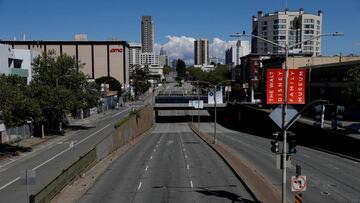Coronavirus in the US: How California is reopening its economy
Counties across the Golden State will be allowed to open up further from the full coronavirus lockdown if they meet certain standards.

The Governor of California, Gavin Newsom, announced a statewide coronavirus stay-at-home order on 19 March, requiring nearly all residents stay at home and limit social interaction. People were only allowed out to shop for food, to seek medical care, look after a relative or friend, or attend an essential job.
Impact of coronavirus shutdown in California
Under the shutdown, 3.2 million people have filed for unemployment in California, while just the initial cost to the state alone was estimated to be $7 billion. GDP across the US as a whole fell almost 5% in the first quarter due to the shutdown orders in March - and the picture for April-June is expected to be even grimmer, possibly up to 40%.
The terrible economic situation has pushed both the Federal government and the states, including California, to seek the fastest ways to open back up, while avoiding the worst effects of the pandemic.
Coronavirus cases in California
In terms of cases, it is worth remembering that California has not been as badly hit by the coronavirus pandemic as some other states in the US. In total California (population 39.5 million) has had nearly 84,000 confirmed Covid-19 cases with 3,2420 deaths, while New York (pop. 19.45 million), the epicentre of the pandemic in the US, has had over 350,000 cases and 28,636 deaths. New Jersey (pop. 8.8 million), the second worst hit state, has had over 150,000 cases and 10,749 deaths.
Initial opening up in California
The initial move to reopen California started on 8 May, when some retail stores across the state were allowed to reopen. Bookstores, music stores, toy stores, florists, sporting goods retailers and others were allowed to provide customers with pick-up service, while manufacturing and logistics in the retail supply chain were allowed to resume activities.
On Tuesday 12 May, Governor Newsom announced new guidelines further easing the restrictions, allowing California to begin opening up amid the coronavirus pandemic, including allowing dine-in restaurants, shopping malls and offices. To apply the guidelines counties have to meet state standards for testing and success at reducing cases of the coronavirus.
When #COVID19 hit--Californians came together and met the moment.
— Gavin Newsom (@GavinNewsom) May 19, 2020
We stayed home. Worked hard to keep each other safe.
Now, we’re starting to re-open our communities. But the fight against COVID-19 isn’t over.
Let’s stay the course and stop the spread. pic.twitter.com/1js8GFCP2F
California speeds up re-opening
This Monday, Newsom announced loosening the rules that would allow counties to apply the new guidelines, effectively allowing 53 of California's 58 counties to move further into the second of the four stages of reopening, if they choose to do so.
Explaining the changes, Governor Newsom talked about progress in coping with the coronavirus, including a stable hospitalisation rate of infected individuals and those in intensive care, as well as increased rates of testing and greater amounts of PPE (Personal Protective Equipment) for medical workers.
Counties will not be prevented from loosening their lockdown rules even if there have been Covid-19 deaths in the previous two weeks, as per the original standard. Urban counties had pressed for that, as they said a single fatality would prevent their opening up. A new standard of allowing opening up if the county had fewer than 25 cases per thousand residents in the previous two weeks has been put in place.
Counties will however still not be allowed to open up if hospitalisations from Covid-19 have increased by more than 5% over a seven-day period, or where the county has seen 20 hospitalisations on any single day in a 14-day period.
In counties meeting the standards and provided the county decides to apply the guidelines:
- Restaurants can open for dine-in service (with a long list of restrictions and recommendations)
- Shopping centres, strip malls and outlet malls can reopen with in-store customers
- Car washes can open
- Pet groomers can resume operating with safeguards
- Non-essential workers who cannot work from home will be allowed to attend offices, provided the offices are modified to prevent the spread of Covid-19.
Related stories
Note that even where businesses open up they will all have to abide by statewide guidelines for physical distancing and cleaning regimes.
Next steps in reopening California
The Governor indicated that the next stages of reopening could be on the horizon, with hair salons able to open as early as the first week of June. Spectator-free sporting events could also be allowed.

